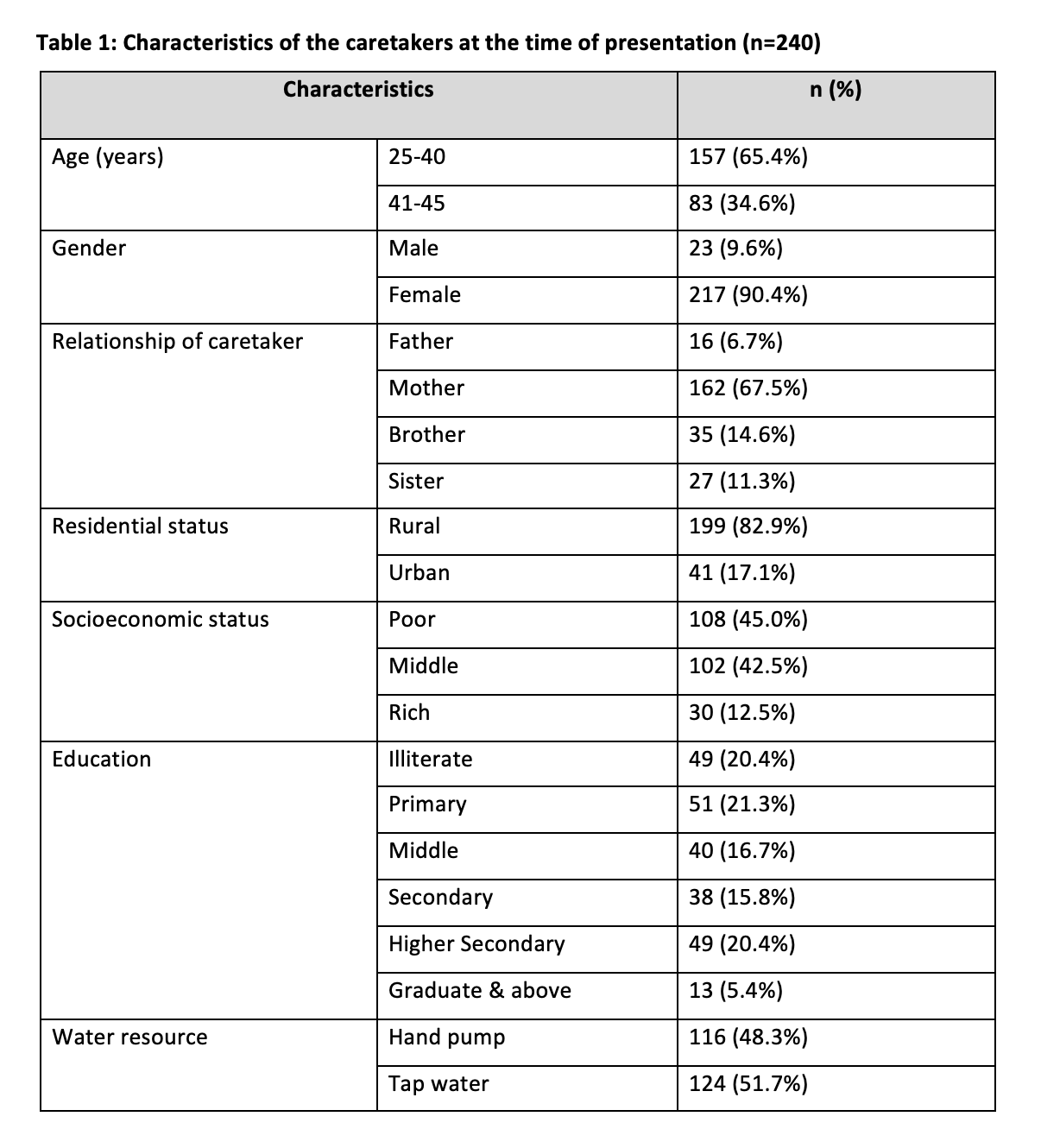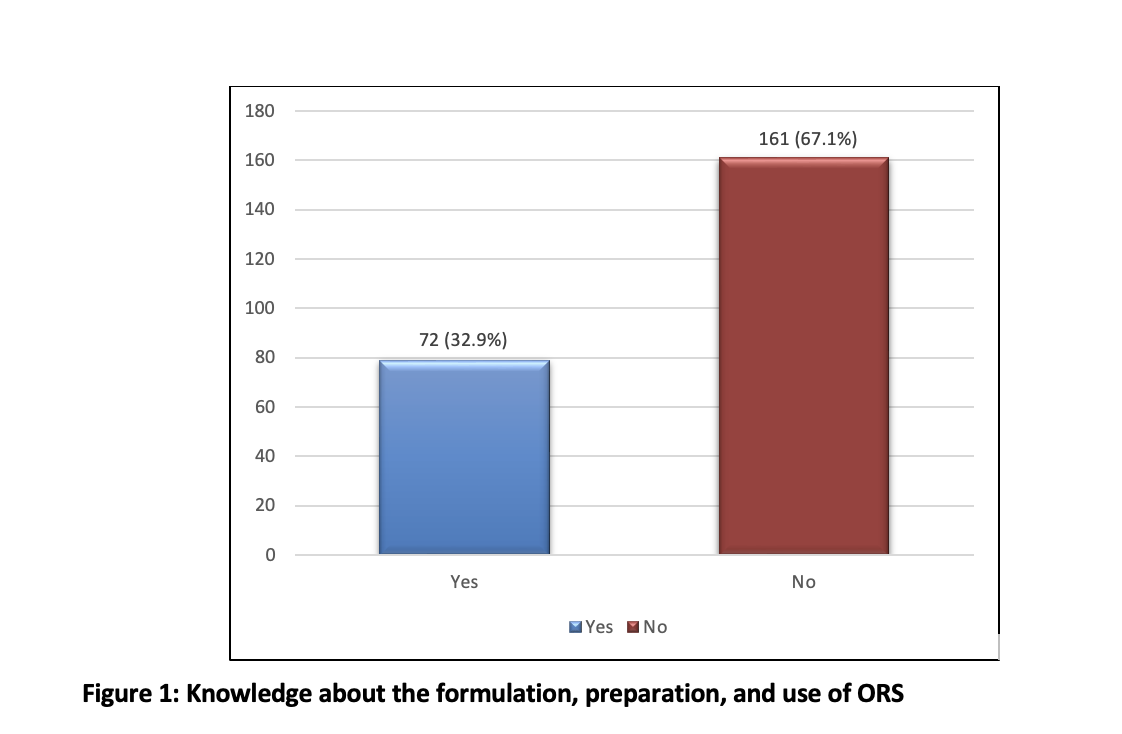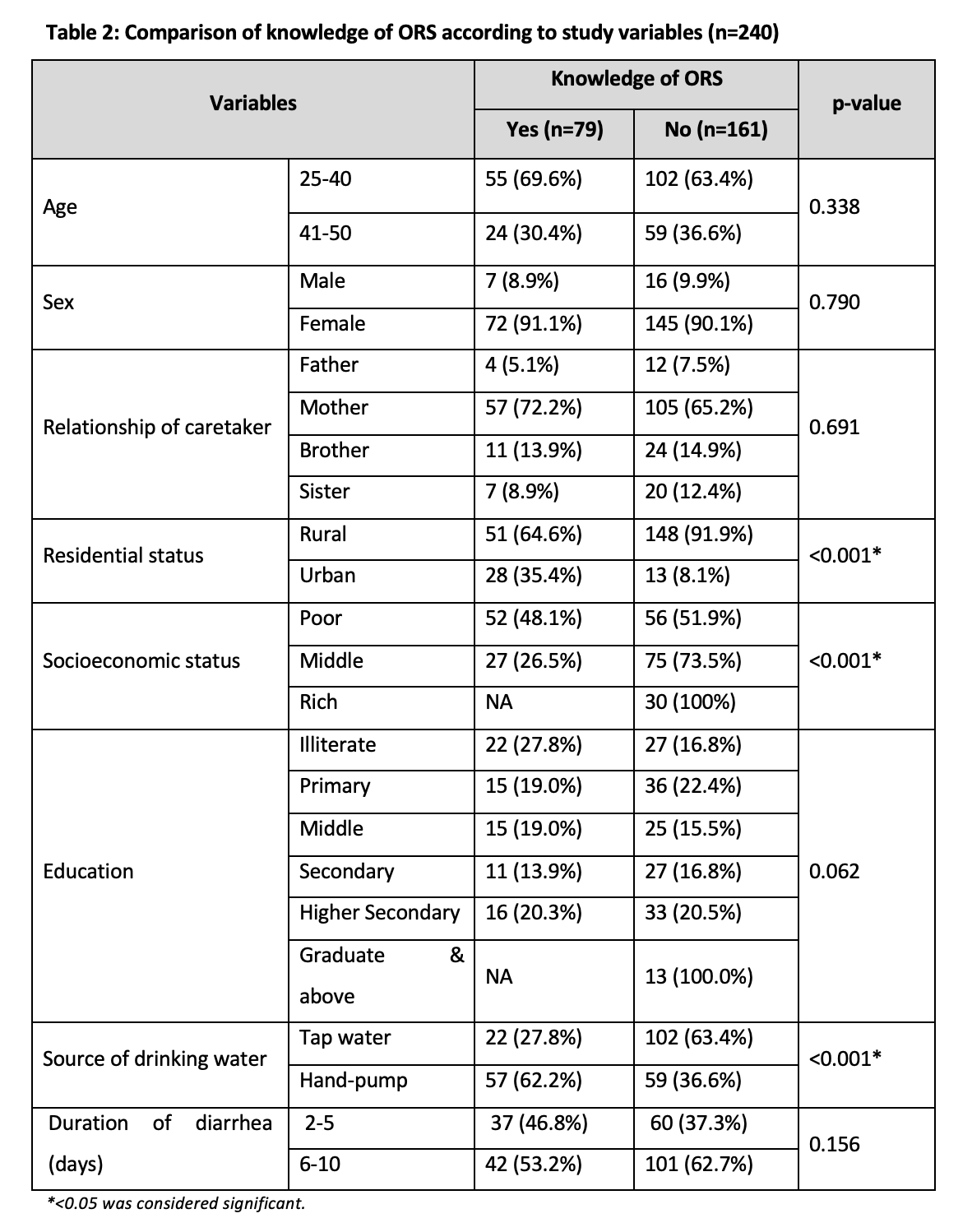By Muhammad Abu Talib1, Sundus Irshad2, Zunaira Malik2
- Pediatric Medicine Department, Tertiary Care Hospital Nishtar, Multan, Pakistan
- Pediatric Medicine Department, Children’s Hospital & Institute of Child Health, Multan, Pakistan
DOI: https://doi.org/10.36283/PJMD12-4/011
How to cite: Talib MA, Irshad S, Malik Z. Knowledge of Caretakers about the Use of Oral Rehydration Solutions in Children with Acute Diarrhea. Pak J Med Dent. 2023;12(4): 57-62. Doi: 10.36283/PJMD12-4/011
Background: Diarrhea is known to be the major factor causing morbidity and mortality, especially among pediatric age groups globally. This study was done to assess the knowledge of caretakers regarding the use of oral rehydration solution (ORS) in children with acute diarrhea.
Methods: This cross-sectional study was conducted at the Department of Pediatric Medicine, Children’s Hospital and Institute of Child Health, Multan, Pakistan, from February 2023 to July 2023. We analyzed caretakers of children aged 1-12 years who presented with acute diarrhea that had less than 14 days of duration. Both male and female caretakers, with ages ranging from 25 to 50 years, were included. Knowledge of the formulation of ORS, the process of its preparation, and usage were asked. Participants describing all correct answers about the formulation, preparation, and use of ORS were considered as having knowledge of ORS. Effect modifiers were stratified, and applying the post-stratification chi-square test, their effects on outcome were observed. A p-value≤0.05 was considered significant.
Results: In a total of 240 study participants, the mean age of caretakers was 36.01±8.08 years. There were 23 (9.6%) male and 217 (90.4%) female caretakers. Among caretakers, 79 (32.9%) had knowledge of ORS while 161 (67.1%) did not know ORS. A statistically significant association of knowledge about ORS was found with residential status (p<0.001), socio-economic status (p<0.001), and source of drinking water (p<0.001).
Conclusion: This study found that among caretakers of children having acute diarrhea, there was a lack of knowledge regarding ORS use, formulation, and preparation.
Keywords: Caregiver, Diarrhea, Knowledge, Oral Rehydration Solution.
Diarrhea is known to be the major factor causing morbidity and mortality, especially among pediatric age groups globally1,2. In certain regions across the globe, diarrhea is responsible for more deaths than all other causes combined. Among these fatalities, childhood diarrhea, which affects children aged five and below, contributes to about 63% of the total global burden of diarrhea3. Diarrhea ranks as the second leading cause of infant mortality in developing countries, where inadequate sanitation and limited access to safe drinking water play pivotal roles4.
The existing body of literature underscores a notable variability in the occurrence rates of enteropathogen isolations within the context of acute diarrhea. This variability can be attributed to the diverse methods and techniques employed for both the sampling and subsequent microbiological analysis of such cases, as they tend to differ significantly among various studies and healthcare settings5. Among these enteropathogens, diarrheagenic Escherichia coli (E. coli) emerges as the most frequently encountered bacterial pathogen associated with acute diarrhea. This bacterial strain is known for its wide prevalence and significance in diarrheal diseases6.
World Health Organization and experts universally recommend a specific approach when dealing with mild to moderate dehydration in children, emphasizing the utilization of commercially prepared oral rehydration solutions (ORS) 7. The rationale behind this recommendation is multifaceted. ORS solutions are widely accessible, allowing for easy and convenient administration, particularly in resource-limited settings. They are well-tolerated by patients and provide appropriate quantities of essential components such as glucose and electrolytes, thus aiding in the restoration of fluid and electrolyte balance. Moreover, ORS is an economically viable solution for managing dehydration in children.
It’s worth highlighting that the effectiveness of ORS in addressing mild to moderate dehydration is on par with intravenous rehydration, an alternative approach. However, ORS holds the additional advantages of cost-effectiveness and a lower incidence of adverse effects, making it a preferred choice in many clinical settings. This dual effectiveness, coupled with its safety profile and economic feasibility, positions ORS as a cornerstone in the management of dehydration associated with acute diarrhea, particularly in pediatric populations7.
Various studies have pointed out that mothers had poor knowledge of the etiology of the disease, symptoms, treatment, and methods to handle diarrheal children 7-9. Since diarrhea causes childhood mortality more frequently around the globe, specifically in underdeveloped countries like Pakistan, extraordinary improvements in the knowledge of caretakers regarding the management and treatment of diarrhea are needed.
This prompted us to design this study so that the knowledge regarding the use of ORS in our population could be documented and useful baseline information about our population could be produced, as no such data from the recent past is available. The results will be helpful for health authorities to take measures to create an awareness campaign among the targeted population to decrease morbidity and mortality due to childhood diarrhea. The objective of this study was to assess the knowledge of caretakers regarding the use of ORS in children with acute diarrhea.
This was a descriptive, cross-sectional study, carried out at the Department of Pediatric Medicine, Children’s Hospital, and the Institute of Child Health, Multan, Pakistan, from February 2023 to July 2023. A sample size of 240 was calculated considering the knowledge of ORS use among caretakers as 19.35%,8 with a 5% margin of error and 95% confidence level, using the formula: n= z2pq/d2. Sample selection was made through non-probability consecutive sampling. Approval from the Institutional Committee was obtained (letter number EC/286/2023). All the parents or guardians were briefed about the objectives, safety, and confidentiality of the study to obtain informed and written consent from them.
Inclusion criteria were caretakers of children aged 1-12 years who presented with acute diarrhea that had less than 14 days of duration. Both male and female caretakers, with ages ranging from 25 to 50 years, were included. Exclusion criteria were caretakers of those patients who had persistent or chronic diarrhea. The mother or any other family member who was actively involved in the patient’s care since the onset of acute diarrhea was considered the caretaker. The caretakers were questioned for their demographic distribution, such as educational level, residential status, and socioeconomic status. Knowledge of the formulation of ORS, the process of its preparation, and its usage were asked.
Using SPSS version 26.0, the analysis of statistical data was performed. Qualitative variables were represented in the form of frequencies and percentages. Effect modifiers like age of respondent, duration of Illness, educational level, source of drinking water, residential status, socioeconomic status, relationship of caretaker, source of knowledge, and gender of respondent were stratified, and applying the post-stratification chi-square test, their effects on outcome were observed. A p-value≤0.05 was considered significant.
Of a total of 240 study participants, 217 (90.4%) were females. The mean ages of the children and caretakers were 6.40±3.544 years and 36.01±8.08 years respectively. In children, there were 136 (56.7%) boys and 104 (43.3%) girls. The mean duration of illness was 6.25±2.58 days (ranging from 2-10 days) and the mean number of stools was 6.65±2.23 per day (ranging between 3-10 stools per day). There were 199 (82.9%) study participants who were living in rural areas. There were 108 (45%) participants who belonged to poor socioeconomic status. The details about the characteristics of study participants are shown in Table 1.

Among caretakers, 79 (32.9%) knew about formulation, preparation, and use of ORS while 161 (67.1%) did not (figure-1).

A statistically significant association of residential status (p<0.001), socio-economic status (p<0.001), and source of drinking water (p<0.001) was found with knowledge about ORS as shown in table-2.

Societies that prioritize the well-being of mothers and children place immense importance on enhancing maternal and child healthcare services. Children, in particular, hold a special significance as their health can be particularly vulnerable to adverse conditions. In the case of infants, especially those in underdeveloped regions, there has been a concerning prevalence of high mortality rates attributed to diarrheal diseases3,4. One pivotal aspect of managing dehydration resulting from diarrhea in children is effective rehydration through the administration of ORS. This simple yet highly effective intervention has the potential to save lives, especially in resource-limited settings7. However, the widespread adoption of this rehydration strategy by mothers for their children hinges significantly on their level of knowledge regarding the preparation and proper usage of ORS10. It is essential to empower mothers and caregivers with the necessary information and education regarding the correct preparation and administration of ORS to ensure its optimal utilization as a life-saving measure for managing dehydration in children suffering from diarrheal illnesses. By improving maternal knowledge in this regard, societies can further bolster their efforts to enhance maternal and child healthcare and reduce the prevalence of diarrheal-related mortality among infants, especially in regions facing significant healthcare challenges.
Within the scope of our study, it was observed that 32.9% of caretakers possessed knowledge about ORS, while a significant proportion, accounting for 67.1%, did not have any awareness regarding ORS. A study conducted by Abdinia et al. in Iran similarly reported that only 19.4% of caretakers knew ORS usage8. Interestingly, another study noted that although 70% of respondents claimed they could prepare salt-sugar solutions, a substantial 72.7% stated a preference for taking their sick children to the hospital rather than using ORS11. In contrast, a different study found that 71.2% of caregivers demonstrated knowledge about ORS, a notably higher proportion than what our study observed12. Additionally, a recent study from Nigeria revealed that 59.2% of mothers exhibited good knowledge of diarrhea prevention and home management, with 47.8% recognizing the role of ORS in treating diarrhea13. Our findings align with those of another study where the researchers reported a low level of awareness regarding home care for diarrhea, consistent with the relatively limited knowledge observed concerning ORS and home-based diarrhea management14. These findings underscore the importance of educational efforts to enhance awareness and knowledge among caregivers, particularly regarding the use of ORS as a vital tool in managing diarrhea effectively and reducing related morbidity and mortality15-17.
Numerous studies conducted in Pakistan have consistently highlighted a concerning trend: many mothers and caregivers continue to address pediatric diarrhea using home remedies or self-prescribed medications, often including antibiotics18,19. Shockingly, only around one-third of caregivers opt for the recommended approach of managing pediatric diarrhea with ORS18-20. These findings shed light on significant issues about the limited accessibility and affordability of ORS, which serves as a substantial barrier to its widespread utilization in Pakistan, particularly in socioeconomically disadvantaged regions21. To address this challenge, concerted efforts should be made to enhance the availability and affordability of ORS22,23. One potential strategy is to provide subsidies that reduce the cost of ORS, making it more accessible to a broader segment of the population. Such interventions can contribute significantly to improving the management of pediatric diarrhea and reducing the associated morbidity and mortality rates, particularly in areas facing socioeconomic challenges 24,25.
The results of this research revealed that the vast majority of the respondents had inaccurate knowledge about ORS use, formulation, and preparation. Being a single-center study, conducted on a relatively small sample size, our findings need further verification in large multicentric trials. We were unable to measure the impact of poor ORS on the disease management of affected children.
Among caretakers of children having acute diarrhea, the knowledge about ORS use, formulation, and preparation was deficient. The present study highlights the need to improve the knowledge and awareness about ORS among the general population. The findings of this study can prove helpful for health authorities to take measures to create an awareness campaign among the targeted population to improve knowledge about ORS which can contribute to decreasing the morbidity and mortality associated with diarrhea, especially among the pediatric population.
The authors are thankful to M. Aamir Latif (RESnTEC) for his assistance in the statistical analysis of this research.
The authors declare no conflict of interest.
Ethical approval for conducting this study was obtained from the ethics committee of the study institute (letter number EC/286/2023).
Informed consent was taken from all patients before obtaining the data.
MAT is involved in the study conception, write-up, critical review, and approval of the final version of the manuscript. SI and ZM contributed to data collection, data analysis, and literature review.
- Saha J, Mondal S, Chouhan P, Hussain M, Yang J, Bibi A. Occurrence of Diarrheal Disease among Under-Five Children and Associated Sociodemographic and Household Environmental Factors: An Investigation Based on National Family Health Survey-4 in Rural India. Children (Basel). 2022;9(5):658. doi:10.3390/children9050658
- Ugboko HU, Nwinyi OC, Oranusi SU, Oyewale JO. Childhood diarrhoeal diseases in developing countries. Heliyon. 2020;6(4):e03690. doi: 10.1016/j.heliyon.2020.e03690
- United Nations International Children’s Emergency Fund 2018. http://www.data.unicef.org/topic/child-health/diarrhoeal-disease/
- Walker CLF, Perin J, Aryee MJ., Boschi-Pinto C, Black RE. Diarrhea incidence in low-and middle-income countries in 1990 and 2010: a systematic review. BMC Publ Health. 2012;12(1):220.
- Chen C, Wang LP, Yu JX, Chen X, Wang R, Yang X, et al. Prevalence of Enteropathogens in Outpatients with Acute Diarrhea from Urban and Rural Areas, Southeast China, 2010-2014. Am J Trop Med Hyg. 2019;101(2):310-318. doi:10.4269/ajtmh.19-0171
- Peirano V, Bianco MN, Navarro A, Schelotto F, Varela G. Diarrheagenic Escherichia coli Associated with Acute Gastroenteritis in Children from Soriano, Uruguay. Can J Infect Dis Med Microbiol. 2018:8387218. doi:10.1155/2018/8387218
- Aghsaeifard Z, Heidari G, Alizadeh R. Understanding the use of oral rehydration therapy: A narrative review from clinical practice to main recommendations. Health Sci Rep. 2022;5(5):e827. doi:10.1002/hsr2.827
- Abdinia B. Knowledge and practice of mothers in the management of children’s Diarrhea, in Northwest, Iran. Arch Pediatr 2014;2(4):e17581.
- Viegelmann GC, Dorji J, Guo X, Lim HY. Approach to diarrhoeal disorders in children. Singapore Med J. 2021;62(12):623-629. doi:10.11622/smedj.2021234
- Olopha OO, Egbewale B. Awareness and knowledge of diarrhoeal home management among mothers of under-five in Ibadan, Nigeria.
- Agbolade M, Dipeolu I, Ajuwon A. Knowledge and Use of Oral Rehydration Therapy among Mothers of under-five children in a Military Barrack in Ibadan, Nigeria. Afr J Biomed. 2015;18(1):7-15.
- Ogbeyi GO, Onyemocho A, Ogbonna C. Assessment of caregivers’ knowledge of diarrhea and practice of home management of diarrhea disease among under two children in Opialu, a rural community in Benue State, Nigeria. Global J Med Public Health 2016;5(2):1-11.
- Momoh FE, Olufela OE, Adejimi AA, Roberts AA, Oluwole EO, Ayankogbe OO, et al. Mothers’ knowledge, attitude and home management of diarrhea among children under five years old in Lagos, Nigeria. Afr J Prim Health Care Fam Med. 2022;14(1):e1-e10. doi:10.4102/phcfm.v14i1.3119
- MacDonald S, Moralejo D, Matthews M. Maternal understanding of diarrhea-related dehydration and its influence on ORS use in Indonesia. Asia Pac J Public Health. 2007;19(1):34-39.
- Khaliq A, Amreen, Jameel N, Krauth SJ. Knowledge and Practices on the Prevention and Management of Diarrhea in Children Under 2 Years Among Women Dwelling in Urban Slums of Karachi, Pakistan. Matern Child Health J. 2022;26(7):1442-1452. doi:10.1007/s10995-022-03391-9
- Pasi R, Divasha, Ravi KS. Impact of educational program regarding ORS therapy on the level of knowledge of mothers aged 18-35 years of under 5-year children. J Family Med Prim Care. 2021;10(8):2834-2838. doi:10.4103/jfmpc.jfmpc_2403_20
- Divasha, Pasi R, Ravi KS. Level of knowledge of mothers (18-35 years of age) of under 5 children regarding ORS therapy. J Family Med Prim Care. 2020;9(9):4747-4750. doi:10.4103/jfmpc.jfmpc_853_20
- Aftab W, Shipton L, Rabbani F, Sangrasi K, Perveen S, Zahidie A, Qazi S. Exploring health care seeking knowledge, perceptions and practices for childhood diarrhea and pneumonia and their context in a rural Pakistani community. BMC Health Services Research. 2018;18(1):44. doi: 10.1186/s12913-018-2845-z
- Khan A, Iqbal Q, Haider S, Khalid A, Hassali MA, Saleem FJJPPCM. Acute diarrheal management in adults: A simulated client study at community pharmacies of Quetta City, Pakistan. J Pharm Pract Community Med. 2019;5(1):13–17. doi: 5530/jppcm.2019.1.3
- Malik MN, Awan MS, Saleem T. Social mobilization campaign to tackle immunization hesitancy in Sargodha and Khushab districts of Pakistan. J Global Health. 2020;10(2):021302–021302. doi: 10.7189/jogh.10.021302
- Ronis KA, Nishtar S. Community health promotion in Pakistan: A policy development perspective. Promotion Et Education. 2007;14(2):98–99. doi: 10.1177/10253823070140022101
- Imran Ali S, Naqvi B, Tasleem S. Mother’s perception and attitude toward traditional dietary approaches concerning the management of childhood diarrhea. BAOJ Pharm Sci. 2019;4:52.
- Bham SQ, Shah MA, Saeed F. Knowledge, attitude, and practice (KAP) of mothers on the use of oral rehydration salt (ORS) in children with diarrhoea: A cross-sectional survey conducted at Dar-ul-Sehat Hospital, Karachi. Ann Abbasi Shaheed Hosp Karachi Med Dent Coll. 2015;20(2):126–131.
- Shewangizaw B, Mekonen M, Fako T, Hoyiso D, Borie YA, Yeheyis T, et al. Knowledge and attitude on home-based management of diarrheal disease among mothers/caregivers of under-five children at a tertiary hospital in Ethiopia. Pan Afr Med J. 2023;44:38. doi:10.11604/pamj.2023.44.38.34431
- Ezezika O, Ragunathan A, El-Bakri Y, Barrett K. Barriers and facilitators to implementation of oral rehydration therapy in low- and middle-income countries: A systematic review. PLoS One. 2021;16(4):e0249638. doi:10.1371/journal.pone.0249638
This is an open-access article distributed under the terms of the CreativeCommons Attribution License (CC BY) 4.0 https://creativecommons.org/licenses/by/4.0/
